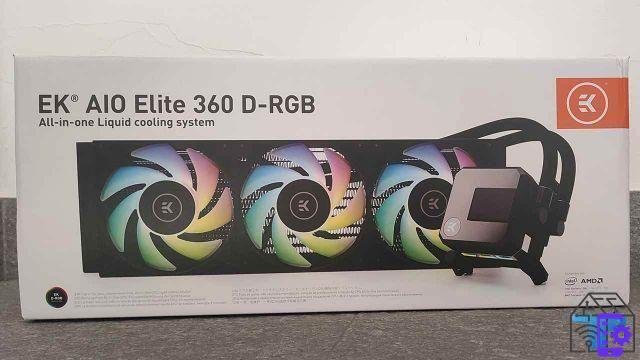
EK Water Blocks is a leading company in the dissipation sector. It ranges from standard AIO coolers to a certain level of custom. The quality is felt, but above all it is admired in the decidedly low temperatures. We had the pleasure of testing the brand new EK AIO Elite 360 D-RGB dissipation system, a stylish all-in-one.
This is a solution from 360 mm, with configuration push-and-pull by default. We ran the processor test i7-8700K. Are you curious to know its performance? Here are all our considerations.
HERE'S WHERE TO BUY EK AIO ELITE 360 D-RGB
Package Contents:
- EK AIO Elite 360 D-RGB
- 6x EK Vadar S 120ER D-RGB
- Fan management kit
- Assembly kit
- Thermal paste
- Instruction manual
CPU Sockets Supported:
- Intel Sockets LGA: 1150, 1151, 1155, 1156, 2011, 2011-3, 2066, 1200
- AMD Sockets: AM4
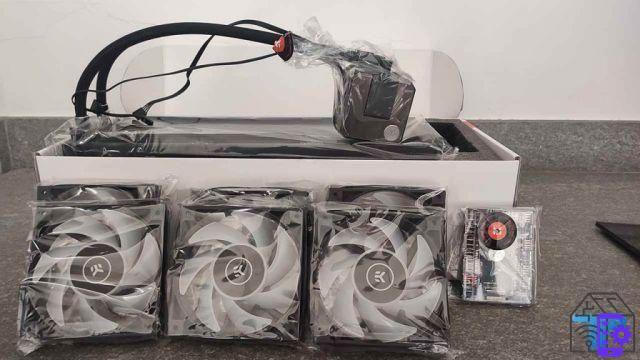 The EK AIO Elite 360 D-RGB definitely has class
The EK AIO Elite 360 D-RGB definitely has class
As always EK WB does not disappoint us in the premium choice of its packaging. Opening the box, we immediately deal with a quality product. The packaging is excellent, rich, everything is sealed, separated and, above all, protected from shocks. Inside the EK AIO Elite 360 D-RGB box, we find 6 fans to assemble. Assembly is very simple, it will be our care to assemble three fans on the front and three on the back of the radiator in a push-and-pull configuration. The heatsink, in fact, was born with this configuration. Of course, if we want to use it in a single configuration, we just need to mount only three fans. 
Effective structure fans
We've already seen the fans in question on other models and liked them a lot. This is the Vardar S 120 ER model. As already mentioned, in the package we will find six of them.
It is a model with an excellent balance, in able to operate at both low RPMs and high RPMsthe. In the first case we will have average performance and reduced noise, in the second, however, perceptible noise, but maximum air flow. The fans can operate in a range between 550 and 2200 RPM (rpm). 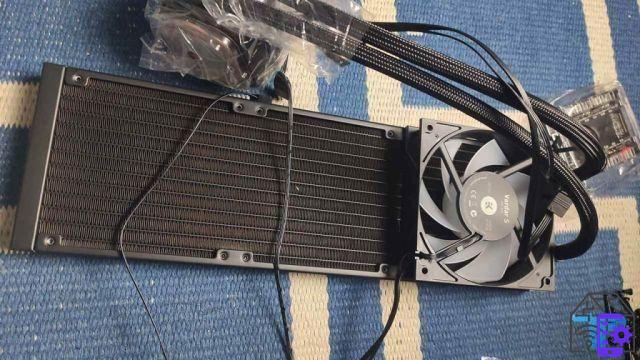
Pump / radiator block
One of the parties The most interesting aesthetics of EKWB heatsinks usually reside in the pump block and, even in this case, the company is doing very well. Same as the 240 D-RGB model, too the EK AIO Elite 360 D-RGB has a square-shaped block, slightly rounded at the corners. Due to its composition in black nickel, the surface that gives a fantastic ed elegant mirror effect. The LED light does not shine through the block as in the previous model, but is present on the base of the same.
Finally, the block presents the EK WB logo in brushed aluminum and an opaque black plastic plate in the center of which the pipes leading to the radiator depart.
The base of the block is made entirely of copper and the dimensions are 88 x 70 x 64 mm, although once assembled these increase. The product comes with pre-installed thermal paste, although there is also a small extra syringe inside the package. In detail, let's talk about the Pasta termica EK-TIM Ectotherm, with a density of 3 g / cm3 and a thermal conductivity of 8,5 W / mK.
Finally, let's also take a quick look at the radiator, the bulkier part of this heatsink. We are talking about an aluminum solution of the size of 395 x 120 x 27 mm circa. However, it is also important to take the fans into account. As mentioned at the beginning, the heatsink is designed to work in a push-and-pull configuration: this means that the basic dimensions must be added to those of the 6 fans (three front and three rear to the aluminum block). The final dimensions will therefore be 395 x 120 x 77 mm.

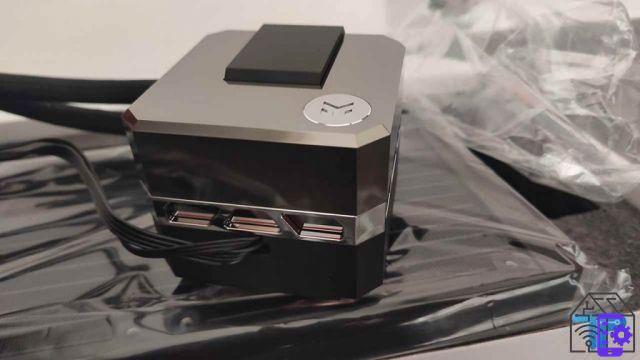


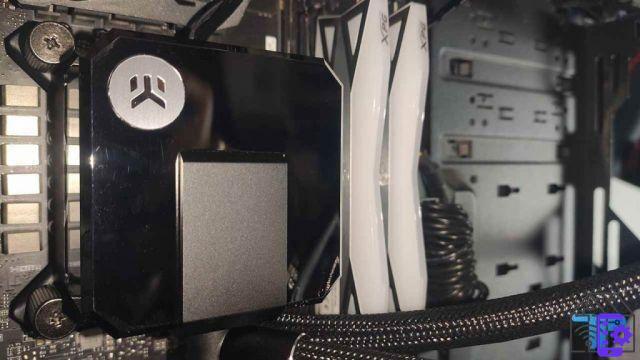
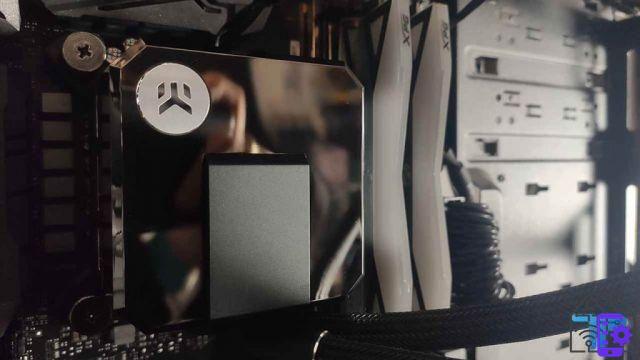
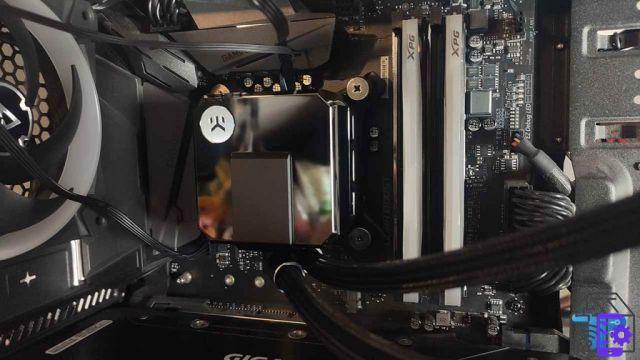
Easy to install?
Assembling the EK AIO Elite 360 D-RGB cooler is quite simple and requires a few easy steps. It is an All-in-one, therefore, pump block and radiator are already together. We are left with the only task of installing the six fans. Three will be on the front of the radiator, three on the back. These must be assembled in a push-and-pull configuration, i.e. the first three must rotate so that the rotation introduces air, the others must follow the flow and push it away.
Once you've finished mounting the fans, it's time to put the block on the CPU. To do this you need to install the back plate on the back of the motherboard. Once fixed, we just have to match the holes and then screw them with the supplied screws.
Finally we have to connect all the wires. We can do this either individually or through the supplied HUB. 
How did this EK AIO Elite 360 D-RGB perform in the field?
Aesthetics are important, but speaking of heatsinks, we have much more to take into consideration. For this reason, we have immediately brought the EK AIO Elite 360 D-RGB to the battlefield.
EK Water Blocks' new sink had to contend with first AIDA 64 and then with some games. The configuration on which we tested it is the following:
- i7-8700k stock (@3,7 – 4,3 GHz)
- MSI Z370 Gaming M5
- 32 GB RAM 3200 MHz
Starting with base temperatures, our i7-8700K registered a idle temperature of about 23 ° C. Compared to its competitors it was the best, considering that the Corsair H100i V2 and Arctic Liquid Freezer II, 240mm coolers, maintained temperatures of 25 ° C and 26 ° C, respectively. The smaller brother of EK Water Blocks, the EK AIO 240 D-RGB, on the other hand, was around 27 ° C.


We then decided to always stress the CPU with AIDA 64 to see how it behaves under load and the result was exceptional. Running a single 100% CPU test, the recorded temperature on the EK AIO Elite 360 D-RGB was 50 ° C on average. We had the highest peak at 54 ° C, the lowest at 47 ° C. Its competitors, on the other hand, ranged from around 53 ° C to 56 ° C.
Stress Test completo
To test the cooler even more deeply, we went into a much more complex stress test. Also through AIDA 64, we started it stress test completo, activating all the parts in the game (CPU, FPU, cache, system memory, local disks and GPU). The result? Crazy.
Temperatures fluctuated much more between highs and lows, but the average remained remarkably very low. We had the maximum peak at 59 ° C, the average turned, however, around 54 ° C.
The ambient temperature was quite high, around 23 ° C and the air was quite heavy, so we wanted to repeat the same test with one outside temperature of 19 ° C. In this case, we compared the two EK WB siblings, the 240 D-RGB and the EK AIO Elite 360 D-RGB, both in push-and-pull, using the extra thermal paste in the box. The result was extremely satisfactory for both solutions. The 360 mm model maintained an average temperature of 42 ° C under stress (unlike the 240 which traveled on an average of 45 ° C).


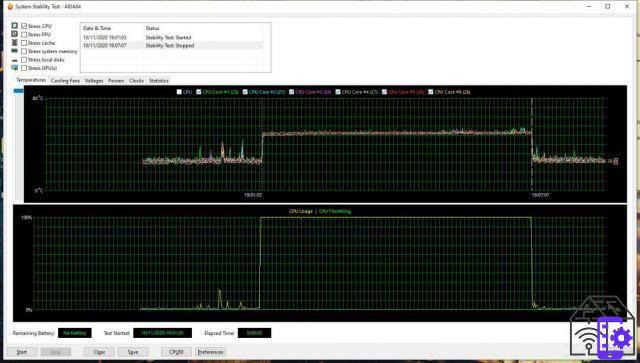
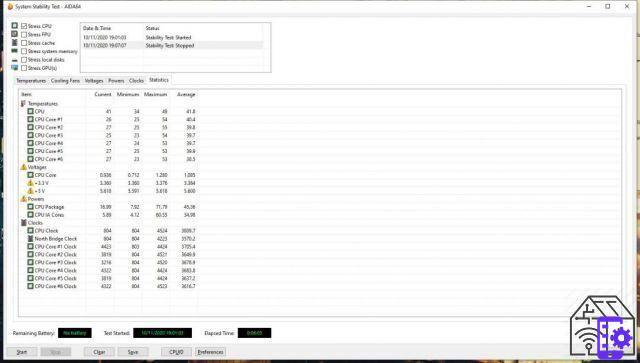
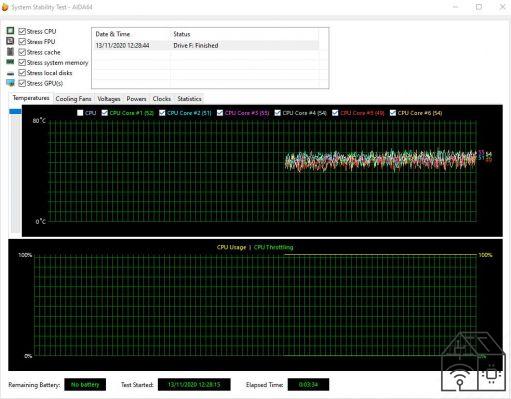
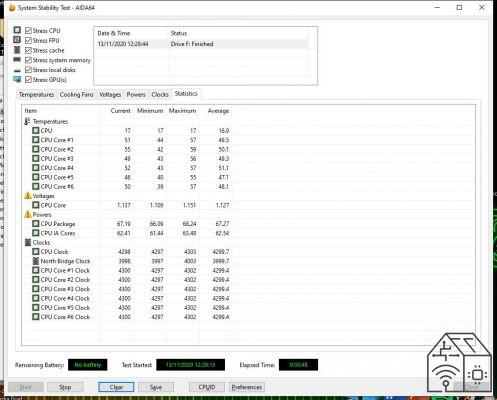
Also at stake is always winter
To give a 360 ° idea of the behavior of our heatsink, we wanted to test it in some games. We tested the results on the latest Assassin's Creed Valhalla, Horizon Zero Dawn, Doom Eternal and The Division 2. The temperatures were exceptional.
Taking into account that you have not always worked 100% with the CPU, given the heavy load on the GPU, we expected low temperatures, but the result was even more interesting. The average temperature held in game was 38 ° C. 
EK AIO Elite 360 D-RGB: is it a good choice?
We come to the end of our tests, providing some final considerations. EK Water Blocks is, without a doubt, one of the best producers of dissipation systems. It manages to create a perfect combination of style, elegance and performance, as few others can do. Its solutions are very efficient and effective. By focusing on our EK AIO Elite 360 D-RGB, we can only say that we have fallen in love. It is beautiful on the outside, but it is above all functional.
The recorded temperatures beat every other heatsink in our possession. Of course, we are talking about a rather bulky solution and suitable for extra large configurations, but even the smallest brother is one of the best in the field. The thermal paste is also really good and continues to be one of the best on the market.
In short, a solution that you absolutely cannot miss and, if you are looking for something a little smaller, choose the little brother EK AIO 240 D-RGB, you will not regret it.


























